Translate this page into:
Mosquito fauna (Diptera: Culicidae) of the Eastern Region of Saudi Arabia and their seasonal abundance
*Tel.: +966 1 4677717; fax: +966 1 4678423 azzam333@yahoo.com (Azzam Mohammed Alahmed)
-
Received: ,
Accepted: ,
This article was originally published by Elsevier and was migrated to Scientific Scholar after the change of Publisher.
Available online 8 December 2010
Abstract
During the period from March 2004 to February 2006, a mosquito (Diptera: Culicidae) survey was conducted in the Eastern Region of Saudi Arabia, and 25 species which belong to 5 genera: Aedes (1 species), Anopheles (13 species), Culex (9 species), Culiseta (1 species) and Uranotaenia (1 species) were collected. The mosquito species encountered were: Aedes caspius Palls, Anopheles cinereus Theobald, Anopheles coustani Laveran, Anopheles d’thali Patton, Anopheles fluviatilis James, Anopheles gambiae Giles, Anopheles multicolor Cambouliu, Anopheles pretoriensis Theobald, Anopheles rhodesiensis Lewis, Anopheles sergentii Theobald, Anopheles stephensi Liston, Anopheles subpictus Grassi, Anopheles superpictus Grasssi, Anopheles tenebrosus Donitz, Culex laticinctus Edwards, Culex perexiguus Theobald, Culex pipiens Linnaeus, Culex pusillus Macquart, Culex quinquefasciatus Say, Culex simpsoni Theobald, Culex torrentium Martini, Culex tritaeniorhynchus Giles, Culex univittatus Theobald, Culiseta longiareolata Macquart and Uranotaenia unguiculata Edwards. Among the mosquito larvae collected, Culex spp. were the most abundant (66.41%), followed by Ae. caspius (17.64%), Anopheles spp. (14.91%), U. unguiculata (1.03%) and Cs. longiareolata (0.01%). The study has shown that the pH and total dissolved salts have no significant effect on the distribution of mosquito larvae. Adult mosquitoes were collected throughout the year, but at different densities depending on the prevailing climatic conditions. The effect of temperature and rainfall on the seasonal abundance of adult mosquitoes in the study area is discussed. The study has shown that mosquitoes are widespread in the Eastern Region, and more studies on their ecology and biology are required before embarking on large scale control projects.
Keywords
Mosquito fauna
Seasonal abundance
Eastern Region
Saudi Arabia
1 Introduction
Distribution of mosquitoes (Diptera: Culicidae) in Saudi Arabia has been investigated by many workers. Mattingly and Knight (1956) studied the distribution of mosquito larvae in the Arabian Peninsula and recorded 46 species and subspecies. In Saudi Arabia they recorded Aedes aegypti, Aedes arabiensis, Aedes caspius, Anopheles cinereus, Anopheles multicolor, Anopheles stephensi, Anopheles coustani, Anopheles turkhudi, Anopheles gambiae, Anopheles sergenti, Culex laticinctus, Culex tritaeniorhynchus, Culex sitiens, Culex sinaiticus, Culex pusillus, Culex tigripes, Culex pipiens and Culiseta longiareolata. In the Eastern Region of Saudi Arabia, Wills et al. (1985) collected Ae. caspius, Anopheles fluviatilis, An. sergenti, Anopheles tenebrosus, Cx. pipiens, Culex quinquefasciatus, Cx. tritaeniorhynchus, Culex univittatus, Uranotaenia unguiculata and Cs. longiareolata. Abdoon and Alshahrani (2003) reported seven species of anopheline mosquitoes in the Asir Region, these were: Anopheles d’thali, Anopheles rupicolus, An. sergenti, An. arabiensis, An. multicolor, An. turkhudi and Anopheles pretoriensis. In the Western Region, Al Ghamdi et al. (2008) reported 11 species which included An. d’thali, An. culicifacies, An. gambiae, An. turkhudi, An. pharoensis, An. sergenti, An. multicolor, An. fluviatilis, Anopheles subpictus, An. stephensi and Anopheles rhodesiensis. Ecology of malaria vectors in Saudi Arabia was studied by Zaher (1973). During the 2000 epidemic of Rift Valley fever in the southern region of Saudi Arabia, Jupp et al. (2002) and Miller et al. (2002) collected 7 species of mosquitoes: Aedes vexans arabiensis, Cx. tritaeniorhynchus, Aedes vittatus, An. azaniae, Cx. pipiens, Ochlerotatus caballus and Ochlerotatus caspius. In another study in the southwestern region of Saudi Arabia, Abdullah and Merdan (1995) recorded the following 9 species of mosquitoes: Ae. caspius, An. arabiensis, An. multicolor, An. sergenti, An. tenebrosus, Cx. pipiens, Cx. quinquefasciatus, Cx. theileri and Cs. subochrea.
The distribution of mosquitoes in Riyadh Region was studied by Buttiker (1981) and Alahmed et al. (2007). During a recent study of adult mosquitoes in the Riyadh Region, Al Kuriji et al. (2007) recorded the following species: Ae. caspius, An. stephensi, An. coustani, An. d’thali, An. pretoriensis, Cx. laticinctus, Culex perexiguus, Cx. pipiens, Cx. quinquefasciatus, Culex simpsoni, Cx. sinaiticus, Cx. theileri, Cx. tritaeniorhynchus, Cx. univittatus and Cs. longiareolata. In the Western Region, Alahmed et al. (2009) and Kheir et al. (2010) reported 18 species of mosquitoes, these include: Ae. caspius, Ae. aegypti, An. azaniae, An. d’thali, An. multicolor, An. rhodesiensis, An. stephensi, An. subpictus, An. turkhudi, Cx. laticinctus, Cx. perexiguus, Cx. pipiens, Cx. quinquefasciatus, Cx. simpsoni, Cx. theileri, Cx. tritaeniorhynchus, Cx. univittatus and Cs. longiareolata.
For the past few decades, Saudi Arabia has witnessed tremendous efforts in social development and urbanization, which have affected insect fauna, particularly the mosquitoes. Expansion of agricultural projects and development of water resources, in addition to the favorable climatic conditions for mosquito survival and developments in some parts of the Eastern Region, have lead to the creation of more permanent and temporary breeding sites for mosquitoes. Scanty information is available on the mosquito fauna of the Eastern Region. The present work was undertaken to study the distribution of mosquitoes in the Eastern Region., as well as the physical properties of water in the larval breeding sites. The effects of temperature and rainfall on the seasonal abundance of mosquitoes in the study area were also investigated.
2 Materials and methods
2.1 The study area
The Eastern Region of Saudi Arabia (Fig. 1) is located along the Arabian Gulf between Sultanate of Oman to the south and Kuwait to the north. The Region is separated from the interior by the sand dunes known as Al Dahna, and is bordered by Al Rub Al Khali or the Empty Quarter desert in the south. The study area lies between the Long. 46 30°–55°E and Lat. 20°N–28°N. Three locations (Al Ahsa, Al Dammam and Hafar Al Batin) were selected for collection of mosquitoes, because of their accessibility, diverse ecology and abundance of mosquitoes.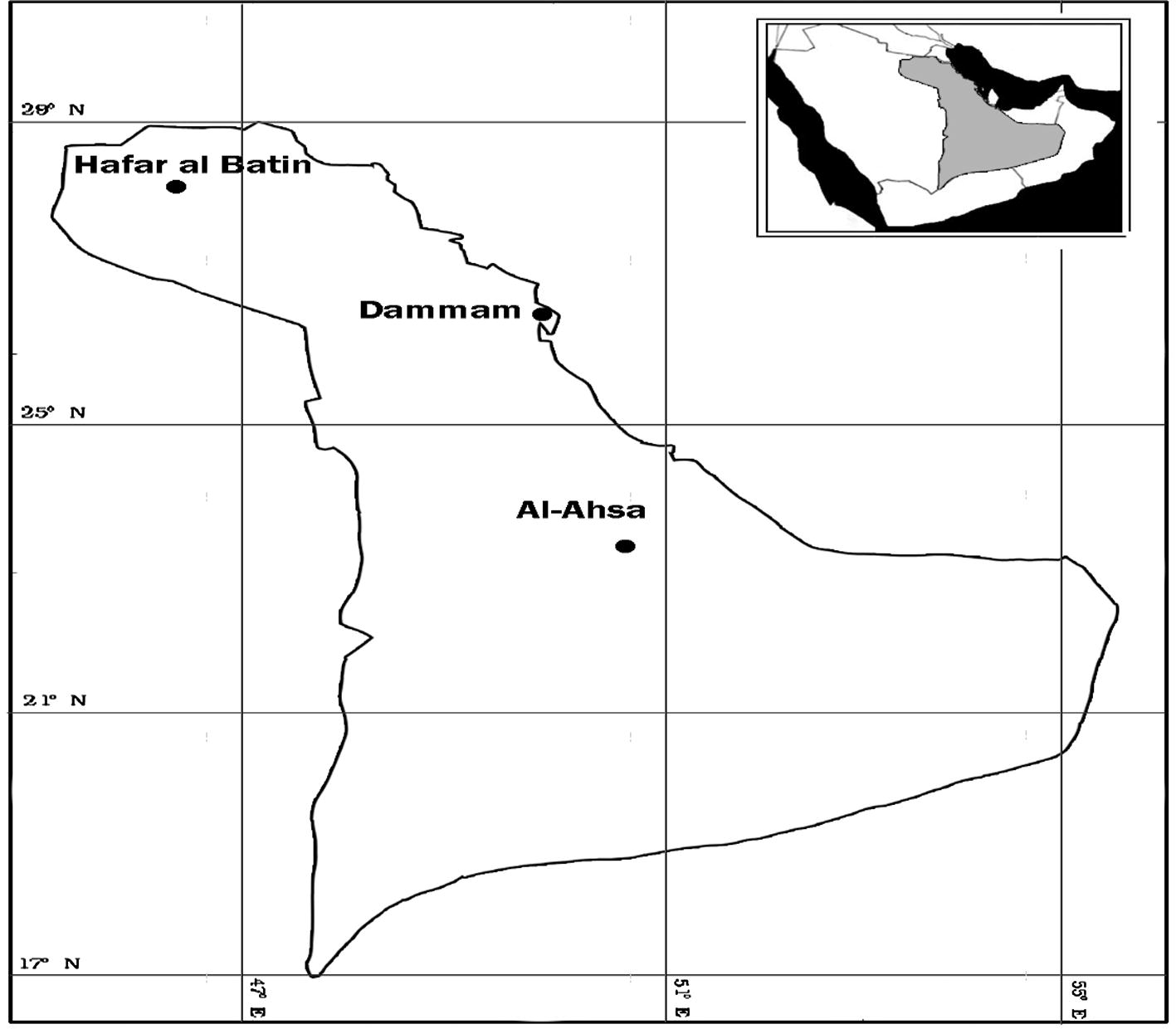
Collection sites of mosquitoes in the Eastern Region of Saudi Arabia.
Al Ahsa is the largest oasis on the Arabian peninsula (Fig. 1). It is about 24 km long and 16 km wide at the southern extremity, in a roughly L-shaped configuration. It has been largely an agricultural oasis, with dates being the main crop. Alfalfa, fruits and vegetables are cultivated through a massive irrigation and drainage system with artesian water being supplied from near surface aquifers Wills et al. (1985). Although Al Dammam area is extensively industrialized, still there are some date palm gardens that retain large amounts of rainwater which provide suitable breeding sites for mosquitoes. Salt marshes, which are widespread in this region, constitute also favorable breeding sites for some mosquitoes in this area (Fig. 1). Hafar Al Batin is a desert area, located in the northeastern part of the Eastern Region. The climate is harsh, hot and dry during summer, and cold and rainy during winter (Fig. 1).
2.2 Larval collection
During the period from March 2004 to February 2006, biweekly field trips were made to collect mosquito larvae from all potential breeding sites in the study area by a standard mosquito larval dipper with extendable handle; and three to five scoops were taken from each breeding site (350 ml each). Larvae were extracted, preserved into 80% ethyl alcohol in glass vials with screw caps, labeled and sent to the Entomology Laboratory, College of Food and Agricultural Sciences, King Saud University, Riyadh. Larvae were mounted as described by R.E. Harbach from Natural History Museum in London (personal communication), and identified using standard identification keys (Hopkins, 1952; Mattingly and Knight, 1956; Harbach, 1988). Representative samples of identified larvae were sent to the British Natural History Museum in London for confirmation. In each larval breeding site, the following information were recorded: coordinates of the breeding site (using GPS), date and time of larval collection, current weather conditions, water temperature, pH, total dissolved salts (TDS), degree of water turbidity and motion, type of breeding site (e.g. irrigation canals, rain water collections, ponds or water storage tanks) and the presence or absence of shadow, algae or aquatic plants. Pearson correlation coefficient (r) was used to study the effects of pH and TDS on the distribution of different mosquito larvae (SAS, 2001).
2.3 Adult collection
Adult mosquitoes were collected from the study area using one CDC and one standard New Jersey (NJ) light traps (Bioquip Company, Gardena, CA 90248-3602, USA) in each collection site (Fig. 1). Each CDC and NJ light trap was attached to a battery that supplies power, and installed near suitable mosquito breeding sites. The light traps were operated once every 2 weeks from sunset to sunrise the following day throughout the study period. The collected mosquitoes were packed, labeled and transported to the Entomology Laboratory, College of Food and Agricultural Sciences, King Saud University, Riyadh. Adult mosquitoes were counted and identified using standard identification keys of Mattingly and Knight (1956), Harbach (1988) and Glick (1992). Some representative samples of identified mosquitoes were sent to the British Natural History Museum in London for confirmation.
3 Results
During the study period, 31,895 adults and larvae of mosquitoes were collected from the Eastern Region, and they represented 5 genera: Aedes (1 species), Anopheles (13 species), Culex (9 species), Culiseta (1 species) and Uranotaenia (1 species). The following 25 species were identified from the study area: Ae. caspius Palls, An. cinereus Theobald, An. coustani, An. d’thali Patton, An. fluviatilis James, An. gambiae Giles, An. multicolor Cambouliu, An. pretoriensis Theobald, An. rhodesiensis Lewis, An. sergentii Theobald, An. stephensi Liston, An. subpictus Grassi, Anopheles superpictus Grasssi, An. tenebrosus Donitz, Cx. laticinctus Edwards, Cx. perexiguus Theobald, Cx. pipiens Linnaeus, Cx. pusillus Macquart, Cx. quinquefasciatus Say, Cx. simpsoni Theobald, Culex torrentium Martini, Cx. tritaeniorhynchus Giles, Cx. univittatus Theobald, Cs. longiareolata Macquart and U. unguiculata Edwards.
Among the 13,908 mosquito larvae collected from the three collection sites (Table 1), 9236 were Culex (66.41%), followed by 2453 (17.64%) Aedes, 2073 (14.91%) Anopheles, 144 (1.03%) U. unguiculata and 2 (0.01%) Cs. longiareolata.
Site
Culex
Anopheles
Aedes
Uranotaenia
Culiseta
Total
Al Ahsa
6817
1776
1136
19
2
9750
Al Dammam
2419
297
1317
125
0
4158
Hafar Al Batin
0
0
0
0
0
0
Total (%)
9236 (66.41%)
2073 (14.91%)
2453 (17.64%)
144 (1.03%)
2 (0.01%)
13,908 (100%)
Study of physical properties of water in the larval breeding sites revealed that the total dissolved salts (TDS) varied between 422 and 11,904 ppm, pH ranged between 5.2 and 9.3, and water temperature varied between 11.4 °C during winter and 40.3 °C during summer. The results have shown that there is no significant correlation between pH and TDS of the water in the breeding sites (Table 2) and the distribution of different mosquito species in the study area (r ⩾ 0.05%). Min: Minimum; Max: maximum.
Site
Ambient temperature (°C)
pH
TDS (ppm)
Min
Max
Min
Max
Min
Max
Al Ahsa
11.4
37.3
5.2
9.3
1664
11,904
Al Dammam
12.9
33.4
7
8.6
1114
9613
Hafar Al Batin
26.1
40.32
7.1
8.2
422
461
Light traps collected 17,987 adult mosquitoes in the study area (Table 3), and Culex were the most prevalent where 11,775 (65.46%) were collected, followed by 4389 (24.4%) Aedes, 1798 (10%) Anopheles, 19 (0.11%) Culiseta and only 6 (0.03%) Uranotaenia larvae
Site
Culex
Anopheles
Aedes
Uranotaenia
Culiseta
Total
Al Ahsa
4086
879
838
4
2
5809
Al Dammam
6682
919
3535
2
5
11,143
Hafar Al Batin
1007
0
16
0
12
1035
Total
11,775 (65.46%)
1798 (10%)
4389 (24.4%)
6 (0.03%)
19 (0.11%)
17,987 (100%)
3.1 Al Ahsa collection site
3.1.1 Mosquito larvae
In this site, 9750 larvae were collected (Table 1), and Culex larvae (Table 4) were the most abundant where 6817 (69.92%) were collected, followed by 1776 (18.22%) Anopheles (Table 5), 1136 (11.65%) Aedes, 19 (0.19%) Uranotaenia and only 2 (0.02%) Culiseta (Table 6). The distribution and collection sites of these larvae are shown in Table 5.
Site
Culex laticinctus
Culex perexiguus
Culex pipiens
Culex pusillus
Culex quinquefasciatus
Culex simpsoni
Culex torrentium
Culex tritaeniorhynchus
Culex univittatus
Total
Larval
Al Ahsa
538
222
2655
150
220
0
0
1301
1731
6817
Al Dammam
53
0
1544
129
113
0
0
433
147
2419
Hafr Al Batin
0
0
0
0
0
0
0
0
0
0
Total
591
222
4199
279
333
0
0
1734
1878
9236
Adult
Al Ahsa
132
367
839
0
276
1
339
2132
0
4086
Al Dammam
0
1535
988
0
288
0
724
3147
0
6682
Hafr Al Batin
0
0
524
0
366
0
0
27
90
1007
Total
132
1902
2351
0
930
1
1063
5306
90
11,775
Site
Anopheles cinereus
Anopheles coustani
Anopheles d’thali
Anopheles fluviatilis
Anopheles gambiae
Anopheles multicolor
Anopheles pretoriensis
Anopheles rhodesiensis
Anopheles sergenti
Anopheles stephensi
Anopheles subpictus
Anopheles superpictus
Anopheles tenebrosus
Total
Larval
Al Ahsa
67
0
189
57
12
141
342
627
0
278
61
2
0
1776
Al Dammam
37
0
46
0
0
45
42
4
0
123
0
0
0
297
Hafr Al Batin
0
0
0
0
0
0
0
0
0
0
0
0
0
0
Total
104
0
235
57
12
186
384
631
0
401
61
2
0
2073
Adults
Al Ahsa
21
0
266
29
0
64
22
54
3
420
0
0
0
879
Al Dammam
0
100
137
47
0
0
0
39
0
551
0
0
45
919
Hafr Al Batin
0
0
0
0
0
0
0
0
0
0
0
0
0
0
Total
21
100
403
76
0
64
22
93
3
971
0
0
45
1798
Site
Aedes caspius
Culiseta longiareolata
Uranotaenia ungiculata
Larvae
Adults
Larvae
Adults
Larvae
Adults
Al Ahsa
1136
838
2
2
19
4
Al Dammam
1317
3535
0
5
125
2
Hafr Al Batin
0
16
0
12
0
0
Total
2453
4389
2
19
144
6
3.1.2 Adult mosquitoes
Light traps collected 5809 adult mosquitoes, and Culex mosquitoes (Table 4) were the most abundant where 4086 (70.34%) were attracted to the light traps, followed by 879 (15.13%) Anopheles (Table 5), 838 (14.42%) Aedes, 4 (0.07%) Uranotaenia and only 2 (0.04%) Culiseta (Table 6).
3.1.3 Seasonal abundance of adult mosquitoes in Al Ahsa Area
The activity of adult mosquitoes was observed throughout the year, but at different densities depending on the prevailing climatic conditions. A peak of activity was attained in June, when the temperature was 36 °C, and it started to decline until reached a minimum in January, when the temperature was 15 °C, and then it started to increase with increase in temperature (Fig. 2).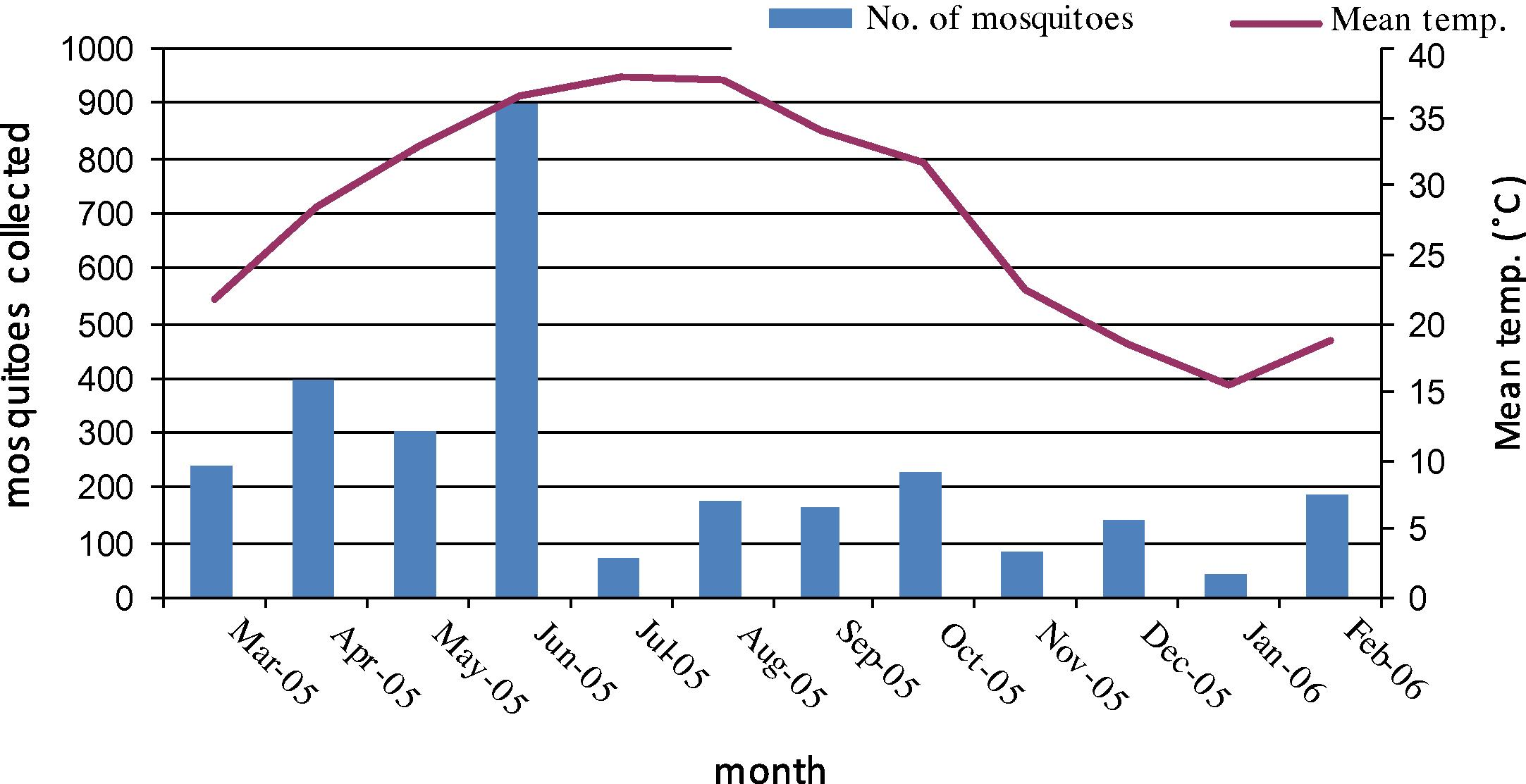
The effect of temperature on seasonal abundance of adult mosquitoes in Al Ahsa Region.
The increase in rainfall during January–March provided more larval breeding sites, and a peak of activity was attained in June. The population density of mosquito started to decrease with the onset of dry season in July (Fig. 3).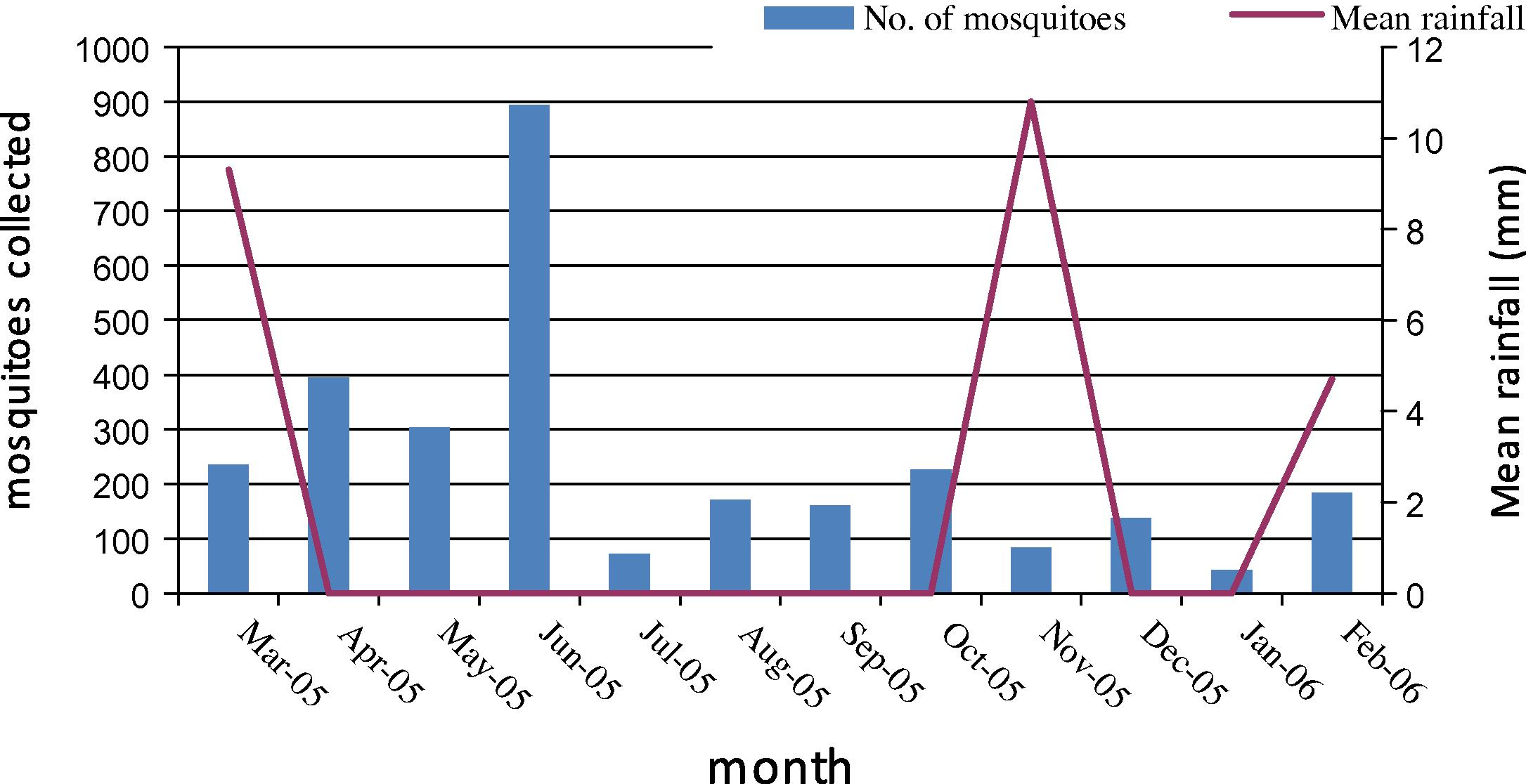
The effect of rainfall on seasonal abundance of adult mosquitoes in Al Ahsa Region.
3.2 Al Dammam
In this site, 4158 mosquito larvae were collected (Table 1), and Culex larvae (Table 4) were the most abundant where 2419 (58.18%) were collected, followed by 1317 (31.67%) Aedes, 297 (7.14%) Anopheles (Table 5) and 125 (3.01%) Uranotaenia larvae (Table 6).
Out of 11,143 adult mosquitoes collected, 7321 (65.7%) were collected by CDC light trap, and 3822 (34.3%) by NJ light traps. Adult Culex were the most prevalent (Table 4), and 6682 (59.97%) were collected, followed by 3535 (31.72%) Aedes, 919 (8.25%) Anopheles (Table 5), 5 (0.04%) Culiseta and 2 (0.02%) Uranotaenia (Table 6).
3.2.1 Seasonal abundance of mosquitoes in Al Dammam District
Adult mosquitoes were available throughout the year, but at different densities depending on the prevailing climatic conditions. A peak of mosquito activity was attained in July when the temperature was 36 °C, and then the population density declined as the temperature decreases. A minimum activity was observed in January, when the temperature was 15 °C, and in March the population density started to rebuild when the temperature was 21 °C (Fig 4).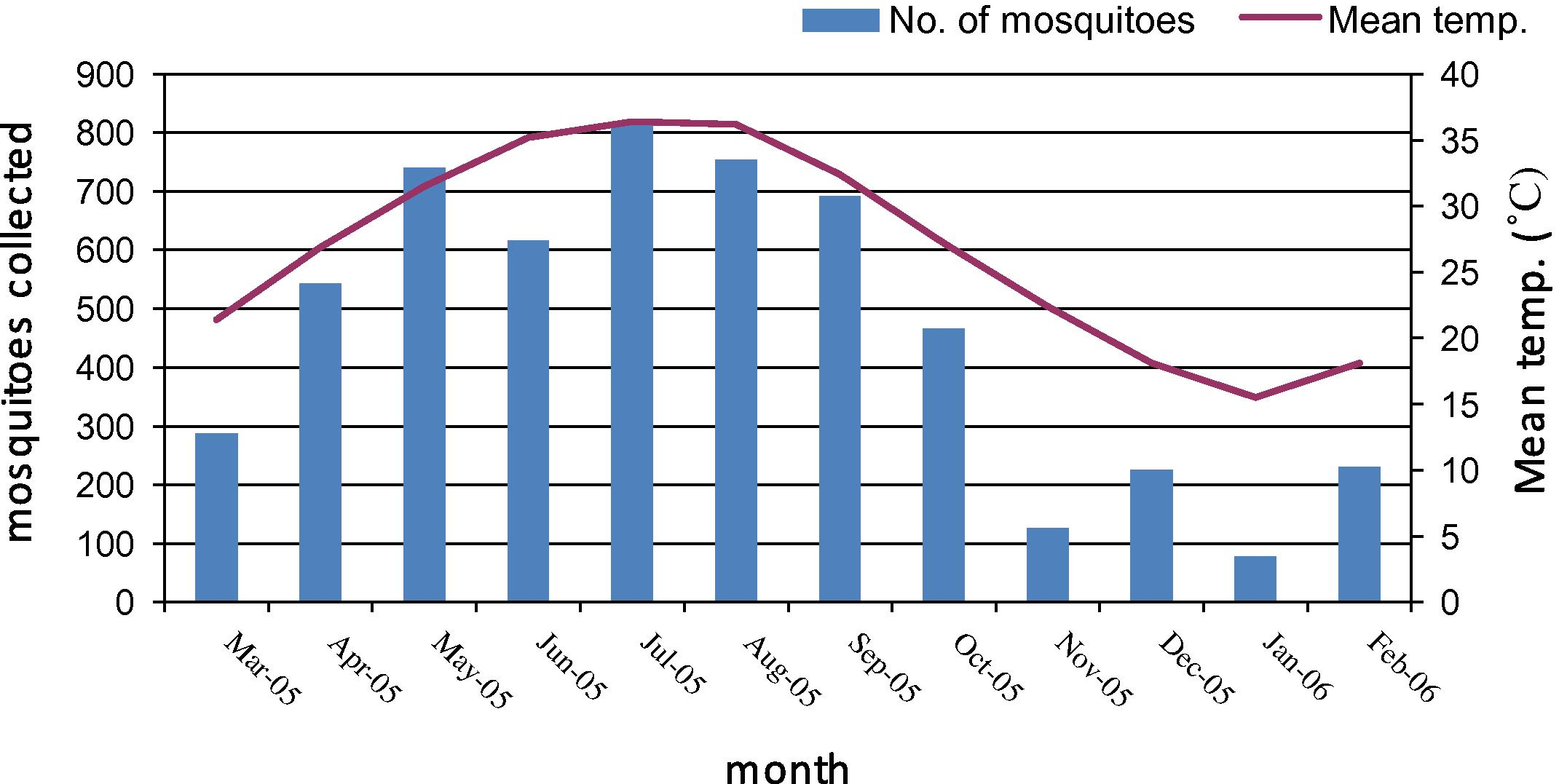
The effect of temperature on the seasonal abundance of adult mosquitoes in Al Dammam District.
The abundance of mosquitoes is closely linked with rainfall and humidity (Fig. 5). The rainfall during January–April provided more breeding sites for mosquitoes which lead to an increase in population density during the subsequent months, and a peak of activity was attained in July.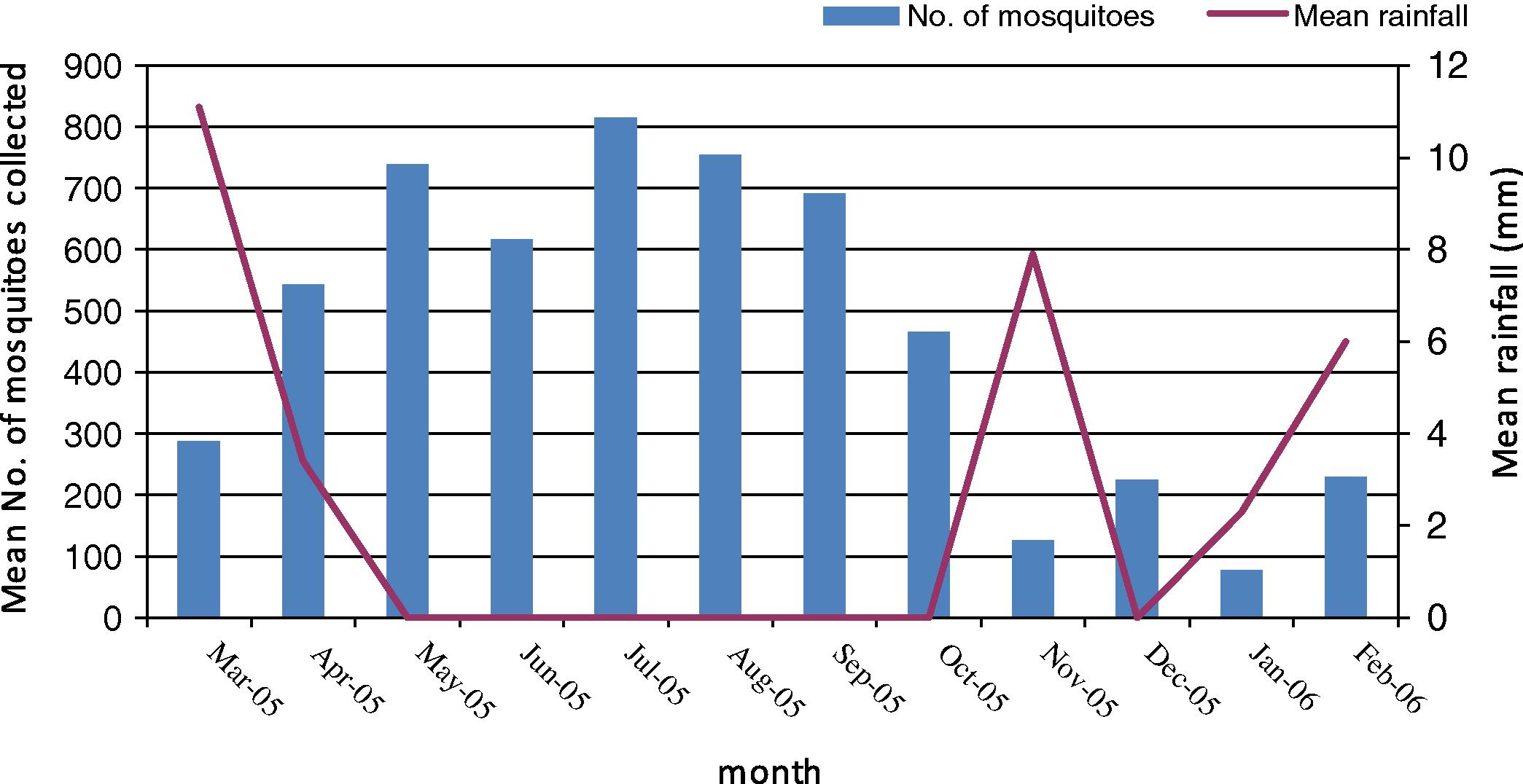
The effect of rainfall on the abundance of mosquitoes in Al Dammam District.
3.3 Hafar Al Batin Region
No mosquito larvae were identified from this site, but during the study, 1035 adult mosquitoes were collected. Adult Culex (Table 4) were the most abundant and 1007 (97.29%) were collected, followed by 16 (1.55%) Aedes and 12 (1.16%) Culiseta (Table 6).
3.3.1 Seasonal abundance of mosquitoes in Hafar Al Batin District
Adult mosquitoes were collected throughout the year (except July–August). The number of mosquitoes collected started to increase in March, when the temperature was about 18 °C, and a peak of activity was attained in May, when the temperature was 30 °C. The mosquito population started to decline in June, and disappeared during the period July–August, when the temperature was above 35 °C. In September, the mosquito population started to rebuild and another peak was attained in February when the temperature was about 15 °C (Fig. 6).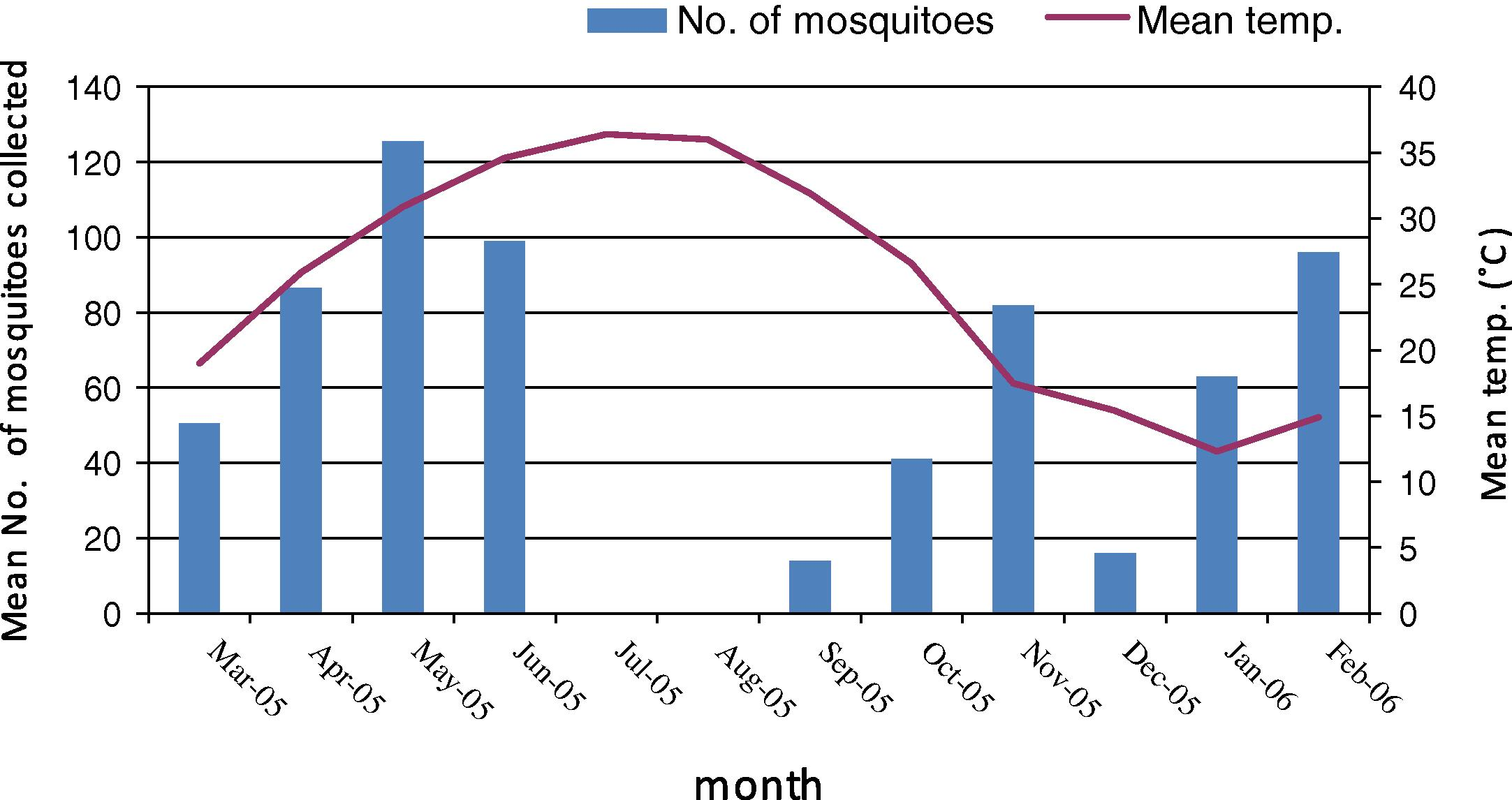
The effect of temperature on seasonal abundance of mosquitoes in Hafar Al Batin.
There is a close link between mosquito activity and rainfall (Fig. 7). The activity of mosquitoes started to increase in November with the onset of the rainy season, and disappeared during the dry season (June–September).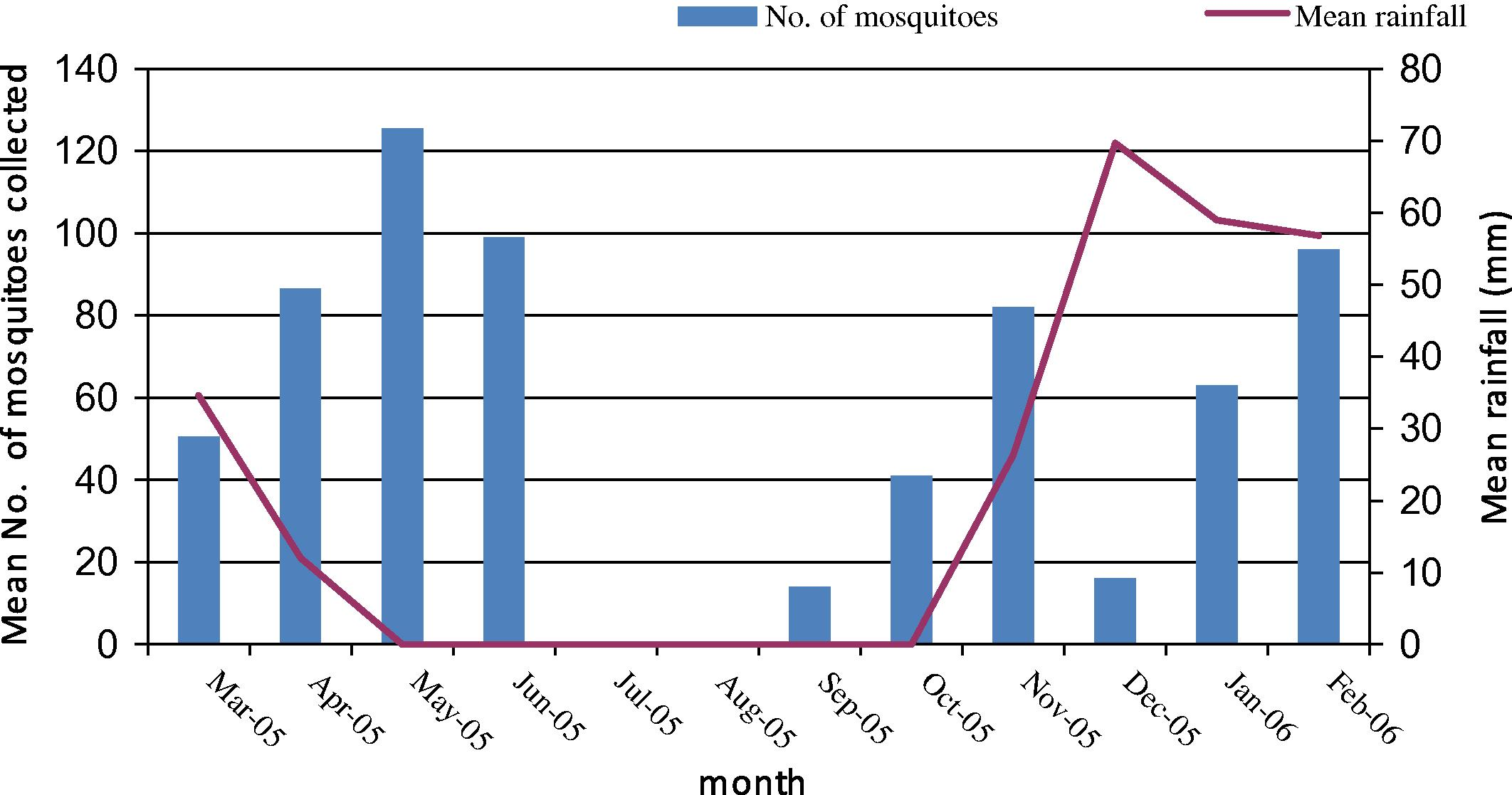
The effect of rainfall on the population density of mosquitoes in Hafar Al Batin.
4 Discussion
This study has shown that Culex species were the most abundant larvae (66.41%) and were collected from various habitats. The wide spreading of Culex larvae might be due to the fact that they can exploit a wide variety of aquatic habitats for their development and survival, and can tolerate highly polluted aquatic environment and relatively saline water. In fact, beside water quality, there are some other factors which determine the suitability of various types of aquatic habitats for mosquitoes, like the presence or absence of shade, aquatic vegetation and degree of water motion and turbidity. Al Zahrani (2007) found that the irrigation systems in Jazan Region can affect the distribution of different mosquito larvae.
In this study, Cx. tritaeniorhynchus, the main vector of Rift Valley fever virus in the southern part of Saudi Arabia (Miller et al., 2002; Jupp et al., 2002), was encountered in the Eastern Region. Wills et al. (1985) also isolated sindbis virus from Cx. univittatus in the Eastern Region. Sindbis virus is a human pathogen causing a dengue-like illness. At the present time, the occurrence of human disease infection with sindbis virus in Saudi Arabia is unknown, but may be encountered in the future. The presence of these serious mosquito vectors constitutes a great health problem, and further studies on their distribution and vectorial capacity in disease transmission are required.
Cs. longiareolata was reported during this study, but in few numbers. The adults of this species never enter houses and rarely bite man (Salit et al., 1994), so this species appears to be of no medical importance, but its larvae may be cannibalistic and prey on aquatic insects and tadpoles (Blaustein and Margalit, 1994).
The results of this study have shown that adult mosquitoes were collected throughout the year in Al Ahsa and Al Dammam, but in different densities. In fact, the climate in these two collection sites is conducive for the development and survival of mosquitoes which make the control programs very difficult. Agricultural expansions and new irrigation canals, pools and extensive farming may also help in the wide spreading and occurrence of mosquitoes in Eastern Region.
In this study, some species of mosquitoes were collected as larvae but not as adults, and vice versa. This might be due to some differences in the adult behavior, since some of these adult mosquitoes are indoors feeders and they do not come near light traps which were placed outside houses. We suggest the use of more efficient methods for sampling indoors mosquitoes (e.g. Anopheles) like the use of spray sheet method.
This study has shown the presence of Uranotaenia mosquitoes in the Eastern Region. The biology, seasonal abundance and the medical importance of this mosquito require further investigations.
In this study, 25 species of mosquitoes were encountered. The presence of these species of mosquitoes in this region constitutes a serious health problem, and further studies on their ecology and biology are required, before embarking on large scale control projects.
Acknowledgements
We would like to thank King Abdul Aziz City for Science and Technology (KACST), Riyadh, for the financial support. Thanks are also extended to Dr. Ralph E. Harbach, from British Natural History Museum, London, for identification of mosquitoes.
References
- Prevalence and distribution of Anopheline mosquitoes in malaria endemic areas of Asir Region, Saudi Arabia. Eastern Mediterranean Health J.. 2003;9(3):240-247.
- [Google Scholar]
- Distribution and ecology of the mosquito fauna in the southwestern Saudi Arabia. J. Egypt. Soc. Parasitol.. 1995;25(3):815-837.
- [Google Scholar]
- Distribution and habitat of mosquito larvae (Diptera: Culicidae) in Riyadh Region, Saudi Arabia. J. King Saud Univ. (Agric. Sci.). 2007;9(2):39-55.
- [Google Scholar]
- Mosquito fauna and seasonal activity in Makka Al Mukarrama Region, Saudi Arabia. J. Egypt. Soc. Parasitol.. 2009;39(3):991-1013.
- [Google Scholar]
- Studies on identification and population dynamics of Anopheline mosquito from Jeddah, Saudi Arabia. Biosci. Biotech. Res. Commun.. 2008;1:19-24.
- [Google Scholar]
- Al Kuriji, A.M., Alahmed, M.A., Kheir, S.M., 2007. Distribution and seasonal activity of mosquitoes (Diptera: Culicidae) in Riyadh Region, Saudi Arabia. In: Agricultural Research Center Publications, King Saud University, Research Article No. 152, pp. 5–17.
- Al Zahrani, M.H., 2007. Impact of irrigation systems on malaria and Rift Valley fever transmission in Jazan, Saudi Arabia. Ph.D. Thesis, University of Liverpool, Liverpool, UK.
- Mosquito larvae Culiseta longiareolata prey upon and compete with tadpole (Bufo viridis) J. Anim. Ecol.. 1994;63(4):841-850.
- [Google Scholar]
- Observation on urban mosquitoes in Saudi Arabia. Fauna of Saudi Arabia. 1981;3:472-479.
- [Google Scholar]
- Illustrated key to the female Anopheles of Southwestern Asia and Egypt. Mosq. Syst.. 1992;24(2):125-153.
- [Google Scholar]
- The mosquitoes of the subgenus Culex in Southwestern Asia and Egypt (Diptera: Culicidae) Contrib. Am. Entomol. Inst.. 1988;24(1):1-240.
- [Google Scholar]
- Hopkins, G.H., 1952. Mosquitoes of the Ethiopian Region. 1 – Larval Bionomics of Mosquitoes and Taxonomy of Culicinae Larvae, London. Printed by Order of the Trustees, 355 pp.
- The 2000 epidemic of Rift Valley fever in Saudi Arabia: mosquito vector studies. Med. Vet. Ent.. 2002;16:245-252.
- [Google Scholar]
- Distribution and seasonal activity of mosquitoes (Diptera: Culicidae) in Al Madinah Al Munwwrah Region, Saudi Arabia. J. Egypt. Soc. Parasitol.. 2010;40(1):215-227.
- [Google Scholar]
- The mosquito of Arabia. I. Bull. Brit. Mus. (Nat. Hist.) Entomol.. 1956;4(3):89-141.
- [Google Scholar]
- Isolation and genetic characterization of Rift Valley fever virus from Aedes vexans arabiensis, Kingdom of Saudi Arabia. Emerg. Infect. Dis.. 2002;8(12)
- [Google Scholar]
- SAS Institute, 2001. SAS System for Windows. SAS Institute Inc., Cary, NC, USA.
- Sindbis virus isolations from Saudi Arabian mosquitoes. Trans. R. Soc. Trop. Med. Hyg.. 1985;79:63-66.
- [Google Scholar]
- Zaher, A.R., 1973. Review of Ecology of Malaria Vectors in the Eastern Mediterranean Region. WHO Report, Geneva, p. 21.







